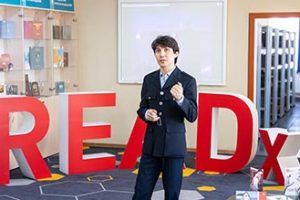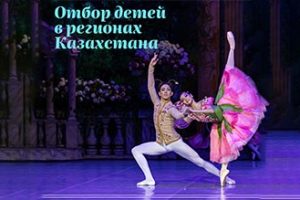The style features of George Balanchine
Interview with the leading soloist of the Astana Ballet Theater Tatyana Ten
On October 17, the premiere of the neoclassical ballet “Concerto Baroque” by George Balanchine to the music of the Concert for two violins and d-moll orchestra by Johann Sebastian Bach took place at the Astana Ballet Theater. One of the main solo parts in the ballet was perfectly performed by Tatyana Ten. She seemed to express the very essence of Balanchine’s choreography. It’s no secret that Balanchine’s productions, despite their apparent lightness, are very difficult to perform, require special techniques and a sense of style. That’s what we decided to talk with Tatyana Ten – the leading soloist of the Astana Ballet Theater.
– The ballet fascinates with its beauty, but at the same time the idea does not leave that all this is very simply done, a minimum of technology, simple movements.
– Of course, speaking of the Concerto Baroque, the movements are simple. The movements are so simple that it can be said, this is a school program of the 5th grade and 1st year. The difficulty lies in the presentation, in style, you need to do everything a little bit in such a jazz character and very musically.

Scene from J. Balanchine’s ballet “Concerto Baroque”.
Photo provided by the press office of the Astana Ballet Theater
– What do you mean “jazz character”?
– These are certain hands, a certain supply of the body, the transition from pose to pose: without fixing the pose itself, you need to do it all very together. And plus musicality. This is the main difficulty. To listen to music, to make the character of the movement, to do it academically and purely, no matter the style – jazz or classical, this is the stunning work.
– The movements need to be done not only filigree, but also at a very high pace in “Concerto Baroque”. Was it difficult for the artists to keep up?
– In order to be in time, it is necessary to correctly place accents, and it begins with a lesson. For example, in the tendu battement – the work of the foot, the emphasis on “and … times”, the emphasis on oneself. That is, we usually devote all our attention to this “and …”, stretching the foot, and this is important. But it is also important that the foot has time to “return” to its original fifth position, to itself. We are still all late, not only children are late, ballet dancers are late. Extend your foot and show this eversion heel – and return it back. This frees the Achilles for the ankle to work. Then the blood circulation will be good and the legs will not clog, numb. All this is anatomy, physiology, but without an understanding of these techniques Balanchine’s technique is very difficult to cope with. Then you have a posture, the top is free and you can express everything that is in music.
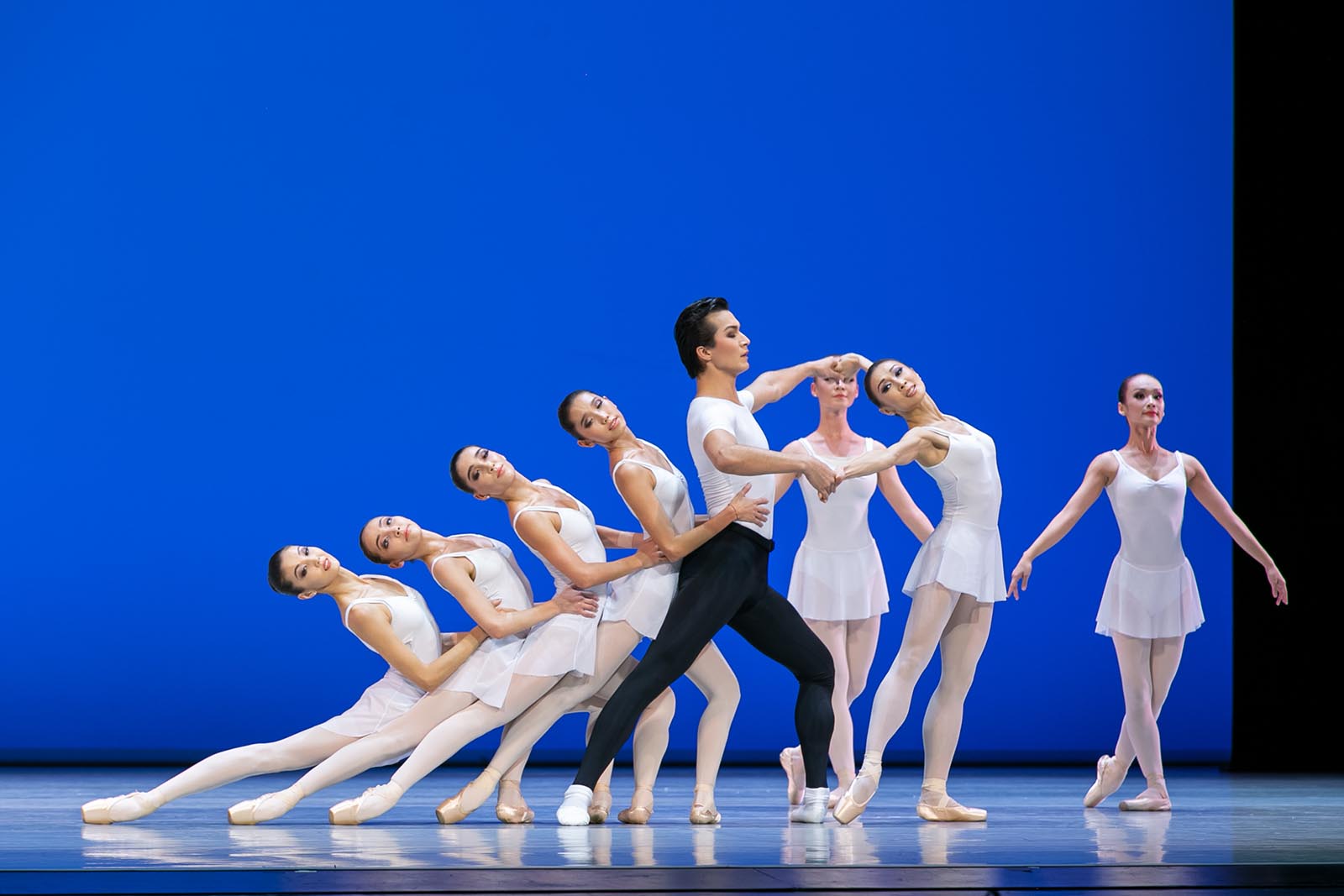
Scene from J. Balanchine’s ballet “Concerto Baroque”.
Photo provided by the press office of the Astana Ballet Theater
– Did you know the Balanchine technique before?
– Before coming to France, I had never encountered George Balanchine’s ballets, and Concerto Baroque was one of the first ballets in which I already danced solo. It was in Toulouse, in the troupe of Nanette Glushak.
When I got into the western troupe, at first I just watched, because I did not know either English or French. I watched how they did, because the troupe was a team – Americans, British, French, Brazilians, and took what could be useful.
I realized that you need to hear music better, that you need to work on technology, I didn’t even have one, you can say. Neither the work of the bottom of the legs, nor the work of the legs in general. Of course, I had a good basic classical school, but everything else had to be rebuilt.
– How did you “build” yourself? Due to what?
– Everything was “built” elementarily, due to positions. Starting from the first position, twist your legs, work on your muscles, taking into account your peculiarity, so that you can be able to own them without thinking about it. My muscles are athletic by nature and x-legs, and you need to be able to master this. Here teachers always told us from school: shoulder blades down. What is it for? It so simplifies the movement, the head is freed, posture is immediately set. You immediately feel your core, and in principle we all know this from school. The teachers told us the same things that I heard from Nanette: everything with hands, everything with head, shoulder blades down, pinch the pelvic muscles. Everything. Everything else will be. But, apparently, you come to this when you encounter a stage task, you need to come to the need for this yourself. So I learned to work, to feel certain ballet muscles, back and internal, which are the strongest, hopping. Plus Nannet gave a little gymnastics, which fastens the hips, for the abs, for the back. Balanchine taught them so.
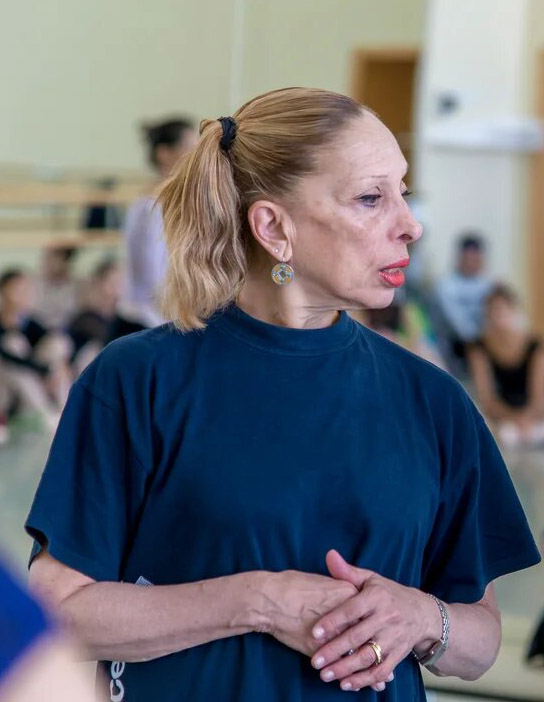
At the rehearsal of the ballet “Concerto Baroque” with Nanette Glushak.
Photo provided by the press office of the Astana Ballet Theater
– But the first acquaintance with Balanchine’s technique for the troupe was the ballet “Serenade” to the music of P.Tchaikovsky. Was it easier to execute?
– You know, the “Serenade” is more dance for me, more flying, I would say. There is more structure to Concerto Baroque, more lyrics can be added to “Serenade”. Moreover, Tchaikovsky’s music allows it.
– And in your opinion, is there a plot? Although Balanchine himself said that it was just dancing in the moonlight …
– Everyone sees the plot in their own way. Since he put this ballet at school, I think he took the plots of different ballets. It all starts with a regular classic lesson. The girl runs into the music (which I play), she seemed to be late for the lesson. Came, late, saw her place, got up. A partner appeared, the class began, everyone danced. In the third part, the girl fell, Balanchine also took this moment from the real situation in the lesson at his school. But here the artistic images of music, generalizations come into force. A dark angel comes with a young man. The choreographer has already taken some other story, inspired by the famous sculpture. And in the end, when the girl is left alone, and the second soloist leads the young man away, she kind of goes crazy and dies. There is already “Giselle”, as it seems to me, although the corps de ballet follows her as in La Sylphide. These are quotes from ballets, but not direct quotation, because Serenade is a hymn to classical dance and romantic ballet, in particular. I even have a mother, not a ballet man, arrived, looked, and saw a completely different story. Even a simple layman understands everything. But everyone sees his own.

Scene from the ballet J. Balanchine’s “Serenade.”
Photo provided by the press office of the Astana Ballet theatre
– Is it difficult by technology? What are the “pitfalls” here?
– Petty technique, jumping technique. The difficulty for the corps de ballet is synchronism, the observance of clear lines, but do not forget about the cantilena, add softness, plasticity, femininity to the performance. It’s hard to do, I know, I myself started with the corps de ballet once. The first soloist has a lot of jumps and spins. But then she has time to rest when I go out. The difficulty is to maintain the style and add your image, your vision.

Scene from the ballet J. Balanchine’s “Serenade.”
Photo provided by the press office of the Astana Ballet theatre
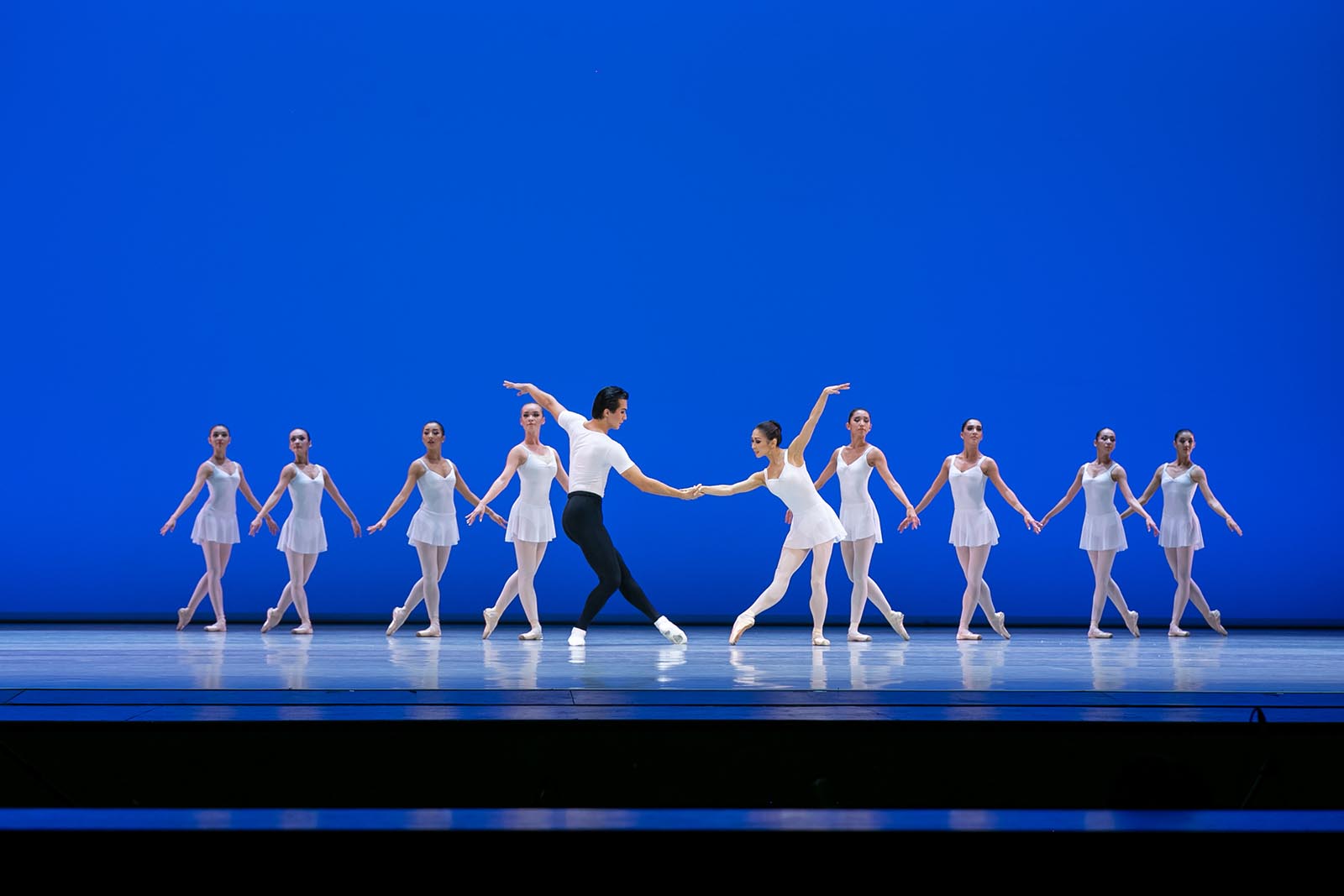
Scene from the ballet J. Balanchine’s “Concerto Baroque.”
Photo provided by the press office of the Astana Ballet theatre
– And is it important that the music is already at the feet, and not only in the head?
– Yes, it’s important for Balanchine to dance not to the music, but to the music itself. So that the viewer really sees the music on stage, the structure of the music. That is, he stopped looking for a plot and excuses – why this is so, but just saw that a musical theme was being developed. Here is the thesis, here is the antithesis, here is the counterpoint – and all this you see clearly. That is why Stravinsky spoke, watching Balanchine’s ballets – I heard my music through my eyes. However, one cannot say that there is no plot. Indeed, in music, as in abstract painting, there is always a plot. But this is not always the story.
– The both performances were transferred to the stage of the Astana Ballet Theater by well-known and authoritative representatives of the Balanchine Foundation, and they also took classes with the troupe. Is there a difference between how Victoria Simon and Nanette Glushak presented Balanchine technique?
– Generally, I did not see much difference. It’s just that each teacher has a different presentation of material. Someone takes immediately the beginning of the ballet and goes sequentially to the end. And someone puts in parts: a certain piece to learn – this is our finale; learn a certain piece – this is our beginning. And then everything collects into a single whole.
– Were there any discrepancies in technique?
– Basically, no, everything was familiar. As Victoria gave all these classes, interesting combinations from which the brains worked very well, so Nanette taught very diverse and competent lessons. They both gave a lesson that will come in handy for you at the performance in the evening.
Let’s say two Balanchine acts and one modern performance in one evening. It’s very hard. And Nanette gave exactly those combinations that we saw in ballet. That is, she already knew that it would come in handy, giving warming up just for that. Victoria is the same. If we have any jumps — jete, battu, temps leve — she gave all this in combination. So that the legs are already brought up from the lesson. It helps a lot, I love when teachers approach the lesson in a practical way. If the artist, for example, has the Nutcracker, then the machine is balanced, so that the artists put their case on. If someone has variations with rotations, they add rotations, but not in pure form, but in a waltz, for example. So that we warm ourselves for a reason, the movement is not for the sake of movement, but preparation for ballets where we participate.
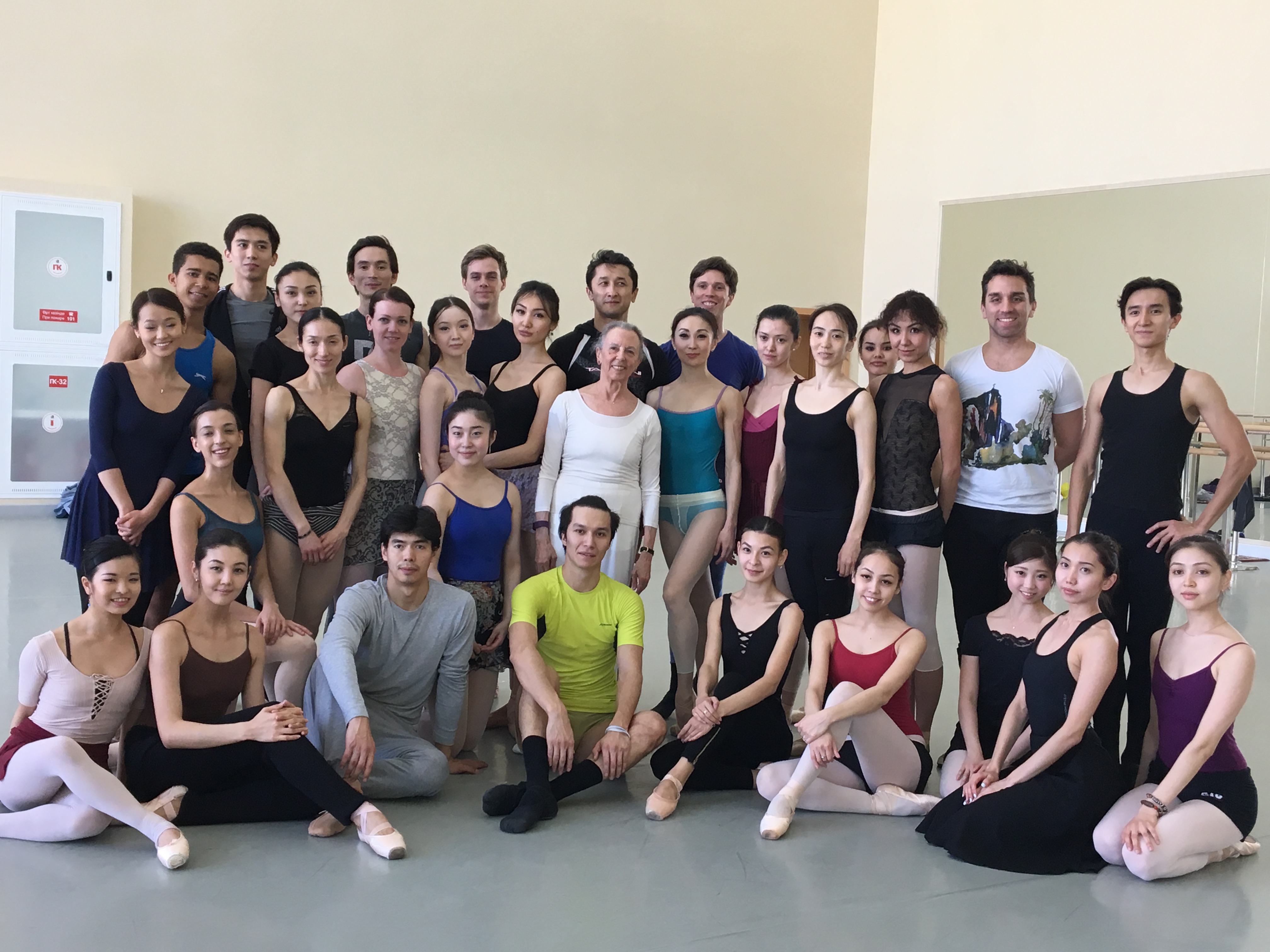
Troupe “Astana Ballet” with Victoria Simon.
Photo provided by the press office of the Astana Ballet Theater
– Artists clearly follow the classic positions of the legs, but their hands are freer. Is this a style feature?
– Quite right, hands have a feature inherent in the style of Balanchine. For example, we are always used to raising our hands through the first position, but with him they can calmly flow through the body. More freely, more relaxed, plastic. During rotation, in order to move faster, you need to hold your hands closer to yourself, then the speed will increase. I think when you dance Balanchine, all these moments come in handy, they give you quickness and speed. In any classical ballet – in The Nutcracker, Swan Lake – of course I will not do this. I will follow traditions, academism, and in the neoclassical style I will dance exactly as Balanchine set it – freely, and I like it. You feel completely different.
– Probably it is very difficult to be a universal artist, switch from classical to modern choreography, from Petipa to Balanchine and Forsythe?
– It is difficult, but very interesting. In order to comply, you need to work on yourself every day, so as not to forget that the body remembers all the nuances of the style. If your body, your instrument, works every day, then you will survive as an artist much longer and better. It is very important. You need to come to the lesson in advance, bask, because everyone’s muscles and feet are different, body physics is different. But those artists who really want to succeed in their profession, they think through every day, every lesson. And if you have the opportunity to dance different productions – both classical, neoclassical, and modern – then you must work three times as much. And not only with your feet, but also with your head – to think what you are doing and how. But this is the artist’s happiness – to play completely different parts and expand his creative range.
Interview prepared by:
Rakhymberdieva Saya Nurlanovna – 4th year student, Kazakh National Academy of Choreography
Academic Supervisor – Musina Flyura Borisovna – Senior Lecturer, Kazakh National Academy of Choreography


